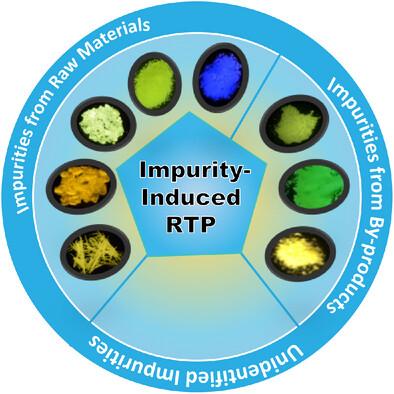当前位置:
X-MOL 学术
›
Adv. Mater.
›
论文详情
Our official English website, www.x-mol.net, welcomes your
feedback! (Note: you will need to create a separate account there.)
Recent Advances in Impurity-Induced Room-Temperature Phosphorescence
Advanced Materials ( IF 27.4 ) Pub Date : 2025-06-04 , DOI: 10.1002/adma.202506549
Zheng Yin, Zhu Wu, Bin Liu
Advanced Materials ( IF 27.4 ) Pub Date : 2025-06-04 , DOI: 10.1002/adma.202506549
Zheng Yin, Zhu Wu, Bin Liu

|
Organic room-temperature phosphorescence (RTP) materials with large Stokes shifts and prolonged afterglows are gaining increasing attention in a variety of applications, including displays, anti-counterfeiting, sensing, and bioimaging. However, achieving high-performance organic RTP remains challenging due to weak spin-orbit coupling, rapid non-radiative decay, and unstable triplet excitons. Early studies focused on crystal engineering, as ordered lattices restrict molecular motion and stabilize triplet excitons. Analyzing crystal structures and packing provides valuable insights into intermolecular interactions, while theoretical calculations have clarified electronic structures, laying the foundation for rational RTP material design. However, recent findings suggest RTP in many single-component systems may arise from trace impurities, significantly influencing RTP properties. This discovery has greatly advanced the understanding of impurity-induced phosphorescence. This review systematically examines the role of impurities in RTP, detailing their origins from starting materials, solvents, and side reactions. It also explores how these identified impurities can serve as essential building blocks for designing new RTP materials. Finally, essential methods for evaluating compound purity, emphasizing the critical importance of rigorous analysis and validation are presented. Material purity plays a pivotal role in RTP research, as impurities can distort experimental data, potentially leading to misinterpretations that can impede advancements in understanding the underlying mechanisms.
中文翻译:

杂质诱导室温磷光的研究进展
具有大斯托克斯位移和长时间余辉的有机室温磷光 (RTP) 材料在各种应用中越来越受到关注,包括显示、防伪、传感和生物成像。然而,由于弱自旋轨道耦合、快速非辐射衰变和不稳定的三重态激子,实现高性能有机 RTP 仍然具有挑战性。早期的研究集中在晶体工程上,因为有序晶格限制了分子运动并稳定了三重态激子。分析晶体结构和堆积为分子间相互作用提供了有价值的见解,而理论计算则阐明了电子结构,为合理的 RTP 材料设计奠定了基础。然而,最近的研究结果表明,许多单组分系统中的 RTP 可能来自痕量杂质,从而显著影响 RTP 特性。这一发现极大地促进了对杂质诱导磷光的理解。本综述系统地研究了杂质在 RTP 中的作用,详细介绍了它们来自起始材料、溶剂和副反应的来源。它还探讨了这些已鉴定的杂质如何作为设计新 RTP 材料的基本构件。最后,介绍了评估化合物纯度的基本方法,强调了严格分析和验证的至关重要性。材料纯度在 RTP 研究中起着关键作用,因为杂质会扭曲实验数据,可能导致误解,从而阻碍对潜在机制的理解。
更新日期:2025-06-04
中文翻译:

杂质诱导室温磷光的研究进展
具有大斯托克斯位移和长时间余辉的有机室温磷光 (RTP) 材料在各种应用中越来越受到关注,包括显示、防伪、传感和生物成像。然而,由于弱自旋轨道耦合、快速非辐射衰变和不稳定的三重态激子,实现高性能有机 RTP 仍然具有挑战性。早期的研究集中在晶体工程上,因为有序晶格限制了分子运动并稳定了三重态激子。分析晶体结构和堆积为分子间相互作用提供了有价值的见解,而理论计算则阐明了电子结构,为合理的 RTP 材料设计奠定了基础。然而,最近的研究结果表明,许多单组分系统中的 RTP 可能来自痕量杂质,从而显著影响 RTP 特性。这一发现极大地促进了对杂质诱导磷光的理解。本综述系统地研究了杂质在 RTP 中的作用,详细介绍了它们来自起始材料、溶剂和副反应的来源。它还探讨了这些已鉴定的杂质如何作为设计新 RTP 材料的基本构件。最后,介绍了评估化合物纯度的基本方法,强调了严格分析和验证的至关重要性。材料纯度在 RTP 研究中起着关键作用,因为杂质会扭曲实验数据,可能导致误解,从而阻碍对潜在机制的理解。


















































 京公网安备 11010802027423号
京公网安备 11010802027423号